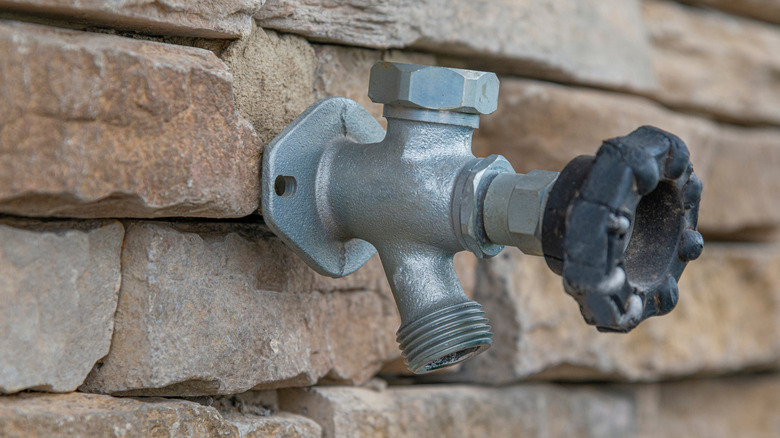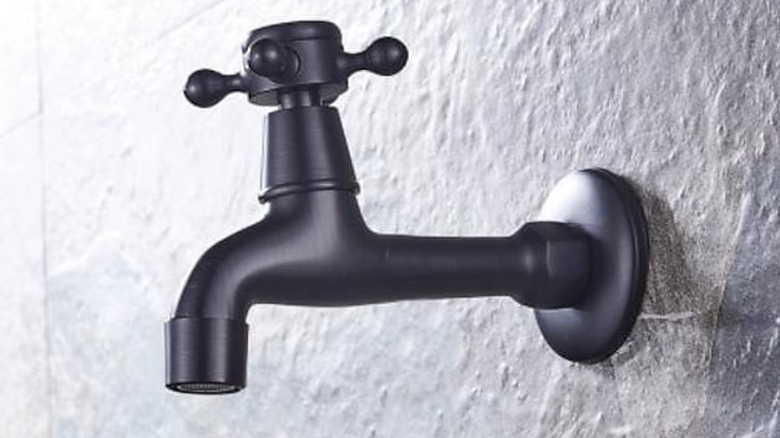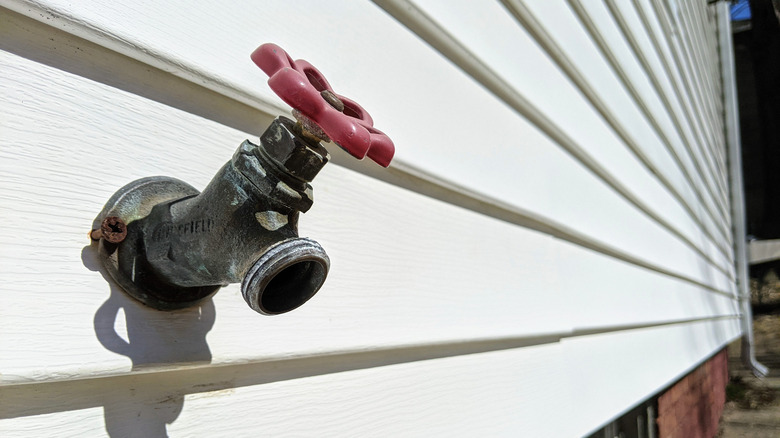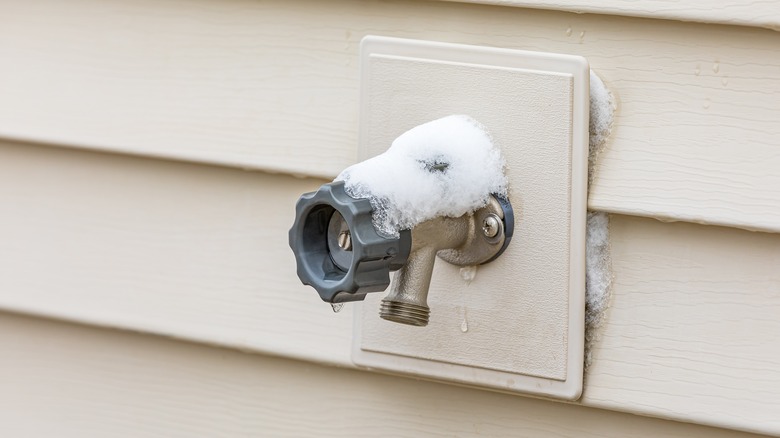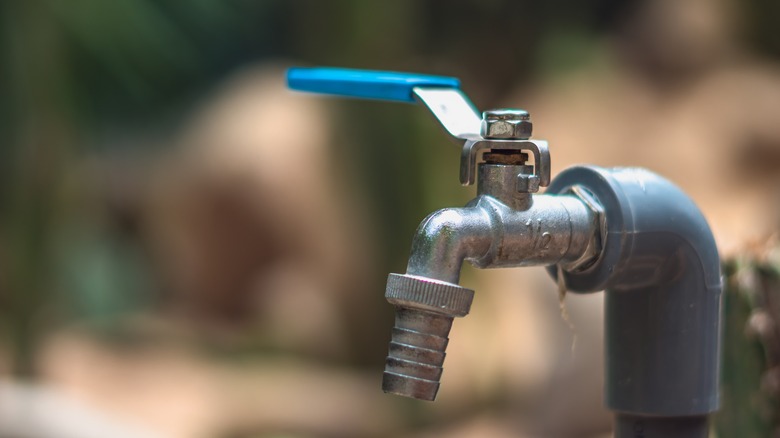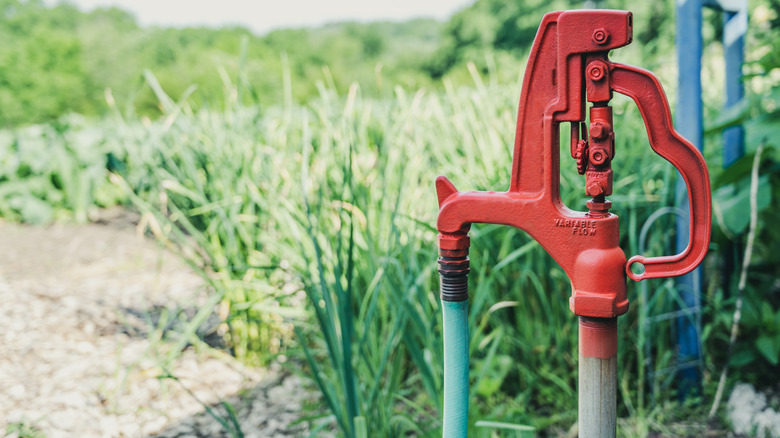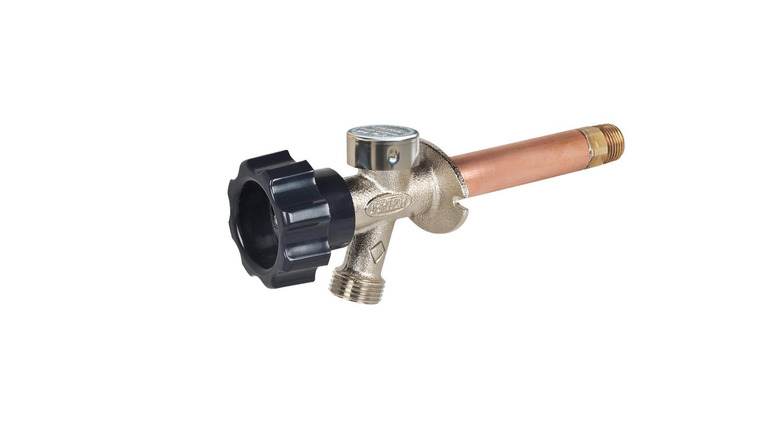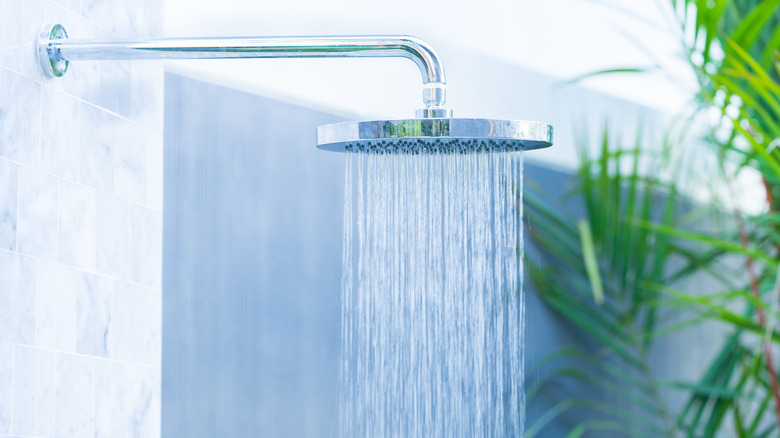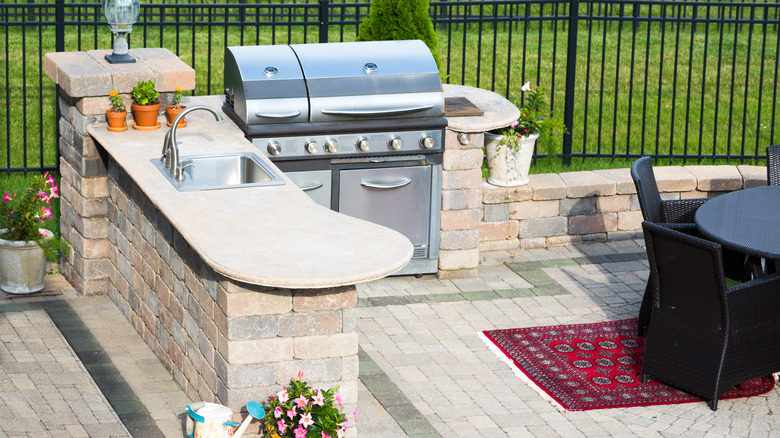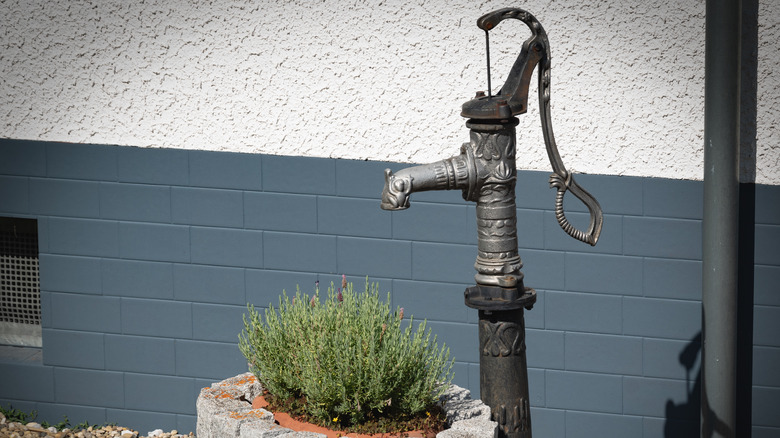What Are The Different Types Of Outdoor Water Spigots?
We may receive a commission on purchases made from links.
If you live in a single-family home, you understand the role outdoor water supply plays in daily life for activities like washing cars, pets, and kids, watering lawns and gardens, keeping water features full and clean, and even having the occasional drink from a hose. You usually get the water flowing by turning on a faucet, which you don't think about much unless no water comes out or, worse, water comes out when it isn't supposed to.
That outdoor faucet, usually a cold-water-only affair, is called a spigot. It's also called a few other things, like hose bibb or sillcock. In the U.K., it's typically called a tap. The mysterious names can give you the impression that it's all very complicated, but it's really not. Essentially, the spigot and its variations are valves, which are ways of starting, stopping, and sometimes regulating the water flow, per InspectAPedia. What sets a faucet, spigot, hose bibb, and sillcock apart from other valves is that you activate them yourself at the point where the water exits the plumbing and becomes something you drink, clean with, or leave on overnight to destroy your hardwood floors. There are other kinds of valves around your home, many equally capable of destruction, found in your hot water, irrigation, pool, water conditioning, and other systems, but none are spigots.
Most spigots are hose bibbs, meaning a garden hose attaches to them. Some decorative faucets, or ones intended for limited use, will be faucets without hose threading. But that thing near the base of your home that water comes out of it will, nine times out of ten, be a hose bibb. Here is everything you need to know about the different types of outdoor water spigots.
The simple, indispensable spigot
The most basic spigot is something you'll primarily find in warm climates, although it's increasingly difficult to find one at all. It goes by several names, including wall hydrant and sillcock, and while it can work in several different ways, most tend to employ similar internal mechanisms. The valve itself is likely to be a compression valve, according to Plumb Smart, even if that's not the best choice for the circumstances.
Compression valves have one distinct advantage and one key disadvantage. Their advantage is that, because of the incremental way the valve is closed by turning a knob several full turns to open or close, you can finely control the amount of water dispensed by the spigot. The disadvantage is that the internal mechanism has several parts that are consumable, meaning that they wear out. Sooner or later, you'll have to replace those parts (usually a washer, sometimes packing material, both of which are readily available at hardware stores) or the whole assembly (via Swan). This repair is most common for fixing a leaky spigot.
When they prevent water from flowing to a separate fixture (like a toilet or a sink faucet), globe valves and their kin, referred to as "stop valves" or "shutoff valves," are no longer considered faucets or spigots (via InspectAPedia). When the spigot and its associated plumbing penetrates the foundation sill of the home, it's called a sillcock. Most of these terms are used interchangeably by the general public because most spigots penetrate the home's foundation. Finally, a wall hydrant can refer to a simple spigot but often refers to special commercial or industrial valves with some combination of key locks or alternative connectors (like push-fit) (via PlumbingSupply).
The hose bibb
A hose bibb may sound different from a spigot or a sillcock, but it is simply a spigot threaded on the business end so that you can attach a garden hose without any adapters. Other than this feature, these are indistinguishable from the average sillcock or spigot. Most things called by any of these names might include this treading. Spigots without garden hose threading (GHT) are comparatively uncommon. Why not be able to attach a hose, after all?
Understanding a little about garden hose threading is practical for a few reasons. First of all, there are two standard garden hose sizes, ⅝ and ¾-inch. Residential hoses are usually ⅝-inch. Both hose sizes usually have ¾-inch GHT connectors, according to Turf Mechanic. These might be designated GHT on their labels, or they might say FHT (female hose thread) or MHT (male hose thread). Not all spigot-related threading is GHT. You might see, for example, that a sillcock is ¾ FIP X ¾ MHT. FIP is female iron pipe threading, and even though they are similar at a glance and have the same nominal size as garden hose thread, they are not compatible (via Pick Hose). If you mess around with garden plumbing long enough, you will eventually pick up one when you want the other.
In addition to hoses, there's a universe of other things that can attach to a hose bibb, such as quick-connect adapters, manifolds to split the flow into multiple branches, shut-off valves, and others. It's generally okay to leave these connected to a hose bibb. Make sure to remove them during freezing weather, even with freezeless hose bibbs, because they can prevent proper draining of the spigot (via Woodford Manufacturing). Use the spigot to turn off the water for long periods, not shut-offs and hose attachments. People will often refer to a GHT-threaded hose bibb as a spigot, but you shouldn't refer to an unthreaded spigot as a hose bibb.
Weatherproof spigots: frost-proof, freeze-proof, or freezeless
Since we mentioned freezeless hose bibbs, let's look at weatherproof spigots. Weatherproofness is a matter of cold tolerance for spigots, not waterproofing. A water spigot can stand up to water, but freezing temperatures are a big problem for simple spigots. You can typically replace them with modified versions called freezeless spigots. These devices have long barrels that run horizontally into the wall, foundation, or sill of a building. Inside is a long stem to move the compression valve from inside the on/off mechanism to inside the house, where freezing is (presumably) less common. Because of this, the spigot's handle will usually be roughly parallel to the wall, per South End Plumbing.
We describe the freezeless spigot barrel as horizontal, but it's not 100 percent level. Freeze-proof spigots are generally installed with the barrel at a pitch of 5 degrees to help water drain away from the spigot housing, which keeps them from bursting in freezing weather (via Home Depot). Some devices, such as the Prier P-164D12 from Amazon, come with flanges angled (4 degrees, in the case of the Prier) to help installers get the drainage pitch right.
Ball valves (quarter-turn)
Most outdoor spigots use globe valves, but it might be a good idea to use a ball valve instead. These require no regular maintenance, while an aging globe valve will almost certainly need internal parts like washers and packing replaced. Ball valves allow you to turn the water flow on or off by moving the handle 90 degrees versus multiple complete turns with other valve types. This turn rotates a ball inside the valve with a hole bored through it for water passage. It's either in a stopped position (no water flow) or an in-use position where water flows through the bored hole and out of the valve, according to Mako Products.
Ball valves are on/off mechanisms that do little to regulate pressure, for which globe valve-equipped spigots are a better choice. You can partly restrict the water flow with a ball valve. However, it will usually create higher pressure than you desire, an unusual angle of exit from the valve, and a lot of aerosolization (misting) of the water. Special v-port ball valves allow for more water flow control, but these are relatively uncommon (via Valtorc International). While the hole in the ball usually restricts water even when fully open, there are full-port versions of ball valves in which the hole is the same size as the input and output connections, so water isn't restricted when the valve is open.
The yard hydrant
If you've spent time at a state park or a farm, you've probably seen a yard hydrant. These freestanding, industrial-looking devices supply water to the distant reaches of large properties while eliminating any threat of freezing or burst pipes, according to Seppmann Enterprises.
Yard hydrants deliver water from an underground supply and include a shut-off valve below the freeze line. The main body is typically cast iron with a large handle lifted to raise internal mechanisms and allow water to flow. The vertical pipe feeding the hydrant head is usually called a standpipe and is made of galvanized steel. However, it might be best to avoid this terminology because a standpipe usually refers to a firefighting water-moving device (especially coupled with the term hydrant).
There are some peculiarities of yard hydrant installation. Some states and municipalities require, for example, that yard hydrants not be installed over a well and not drain to soil (via the Wisconsin DNR). Check your local plumbing codes when planning for a yard hydrant.
Backflow preventers
Anti-siphon spigots or spigot attachments are common and sometimes even required for newer homes. They prevent contaminated water from being sucked back into the freshwater supply (say, from a garden hose coiled in dirty water) when water pressure fluctuates. The most common of these is the anti-siphon valve, which includes an integrated vacuum breaker to eliminate the pressure differences that can cause contaminated water to be sucked back through the supply line, per Upgraded Home. You can install these devices at the water source and at least six inches above the ground. Plumbing code often requires anti-siphon devices on hose bibbs.
There are other types of backflow preventers used for various circumstances and purposes. Atmospheric vacuum breakers are a standalone version of the vacuum breaker that's integrated into anti-siphon spigots. Double check valves are common for underground plumbing and consist of (you guessed it) two check valves in series. They are for situations where backflow and back siphonage aren't unusually hazardous. Pressure vacuum breakers include a check valve and an air inlet that evens out pressure in order to prevent back siphonage. Spill-resistant vacuum breakers solve the common problem of leaky pressure vacuum breakers. Reduced pressure (RP) assemblies are the best and most expensive common type of backflow preventer. RP devices include two independent check valves, a pressure differential release valve, and a relief valve to keep pressure low between the check valves. RP devices are a great solution in high-hazard areas and situations (via Ready & Able).
Outdoor showers
Outdoor showers are one of the few outdoor places where you'll commonly (but plumbingnot always) find hot water. Hot water is never worth the trouble for garden hose purposes and is often not even necessary for outdoor kitchens or greenhouses. However, many consider it indispensable for a shower for reasons that are probably obvious. Signature Hardware points out that many shower valves specifically designed for outdoor use include only a cold-water inlet. Hose-attached shower models (cold water only, obviously) aren't spigots in even the loosest sense, as they are not attached to standard plumbing pipes. When you use hot water, ensure there's either an integrated or a separate mixing valve to prevent scalding hot water from being dispensed by the shower.
Purpose-built outdoor shower components might incorporate more weather-resistant materials in their construction. Some are otherwise very similar to standard indoor showers, except with plumbing that tends to be more exposed than normal. You might also find special features such as foot-rinsing outlets, free-standing, and all-in-one units. Outdoor showers, like most outdoor plumbing fixtures, must be winterized. This step involves opening all the valves and turning off the supply line to let the valves drain fully. Then remove your shower head and store it indoors until the threat of a freeze has passed (via Encore).
Outdoor kitchens and greenhouses
An outdoor kitchen is exactly what it sounds like: most of the trappings of a kitchen, if more primitive and more weather-resistant. They usually include hot water, and though it's not always necessary, it's beneficial for cleanup and hand-washing. For the faucet, you can try to track down an all-stainless model, says Kalamazoo Outdoor Gourmet, but most are brass with a physical vapor deposition (PVD) finish. These finishes are durable and will not tarnish (via California Faucets). Avoid plastics and rubber components (including internal ones) whenever you can, as they will break down over time when exposed to sunlight and weather.
Outdoor kitchen faucets will rarely be freeze-proof, meaning they'll need to be winterized in most U.S. climates. The way to accomplish this varies by installation. Conceptually, it is very similar to winterizing an outdoor shower: cut off the water supply from the house, then open all the taps downstream from that shutoff. Ideally, this would include a drain at a low point in the outdoor kitchen plumbing.
The same concerns might be involved in greenhouse plumbing, especially if you want a standard faucet/sink and hot water. In most cases, a simple hose bibb (and probably a manifold to split the water line for misting, hydroponics, drip watering, and automatic watering). You'll be slightly less likely to need a freezeless faucet in a greenhouse. However, greenhouses do freeze, and you won't have the protection of interior spaces that usually make freeze-free devices work, so plan for some winterizing (via Greenhouse Gab).
Standpipes and other oddities
Plenty of plumbing devices, many of which are valves but none of which are spigots, still manage to find their way into conversations about spigots, so it's worth the trouble to take a quick look at them. Other valves around your yard include electric solenoid valves, stop-and-waste valves, and various valves related to wells and irrigation systems. We're touching on standpipes and emergency shut-offs to help avoid confusion.
First, standpipes. As we have seen, a standpipe is a component of a yard hydrant that frequently refers to a system of pipes that create points of water access for firefighters, typically in a commercial or large multi-family residential building. Per the National Fire Protection Association, the average homeowner will have little reason to worry or even think about standpipes.
However, you will want to know about your emergency shut-off valves. While they are not spigots, they are important for operating spigots. You will need to access these valves from time to time to perform maintenance on plumbing or to avoid a flood if something has gone wrong with your freshwater plumbing. Your entire property should have a main shut-off that turns off all the water. Faucets, toilets, outdoor spigots, and everything else should have an additional shut-off so that you don't have to shut down everything to re-pack a hose bibb. Shut-offs are usually near the plumbing fixture they service, though, in the case of systems that home-run water lines from a central point to each fixture, some or all of the individual shut-offs might be at the manifold. Water heaters, ice makers, washing machines, and other appliances will also generally have their own shut-off valves (via Marklein Plumbing).
